A GUIDE for parents and other adults who are concerned about how much young people spend on the computer (social networking sites, such as Facebook, instant messaging or online games) or those who want to learn more about Internet Addiction and Internet Gaming Addiction.
Presented by Ofer Zur, Ph.D. (Digital Immigrant*) & Azzia Walker, B.A. (Digital Native*)
Table Of Contents
Parents’ Distress
On Digital Immigrants and Digital Natives
Differences Between the Generations
Summary of the Complexities, Differences, Problem
On Multitasking
The Generational Clash Crisis
Cycle of Parents’ Ineffective Behavior
Use and Abuse of the Internet and Gaming
Online Gaming – An Informed View
A Guide for Concerned Parents
Assessment, Evaluation and Warning Signs of Internet Addiction
Kids Abusing the Web & Gaming: Intervention and Treatment
On Balance
Summary
Zur Institute’s Resources
Online Resources
Parents who see their children spend many hours every day on their computers, cell phones, and PlayStations are understandably distressed and concerned. They often tell their children:

- You’re wasting your time on the computer!
- Stop checking your Facebook and email every 2 minutes and start concentrating on your homework!
- You’re wasting your life playing these meaningless online games!
- Stop all these chats and texts, you need sleep!
- You are going to fail school if you keep this up.
- You fry your brain with all this technology. Read a book!
- Spend some time in the real world!
- Don’t you have regular friends?
- Why don’t you play sports any more?
- What are you doing on the computer all day?!
- Get a life!
On Digital Immigrants and Digital Natives
The terms “digital immigrants” and “Digital natives” was reportedly originally coined by Mark Prensky. Generally, these terms designate people born in the digital era (Generation X and more recent, Digital Natives) and people born before the digital era (Baby Boomers and older, Digital Immigrants).  It is important to realize that not all digital immigrants and not all digital natives are created equal. While most digital natives are tech savvy by default of their being born around technology, others do not have a knack for technology and computers, nor an inclination. Similarly, Digital Immigrants fall into three major groups: Avoiders, Reluctant Adopters and Enthusiastic Adopters. We have all met avoiders, so prefer a lifestyle that leaves them relatively technology-free or minimal-technology. They tend to have a land-line, but no cell phone or email account. Reluctant adopters realize technology is a part of today’s world, and they try to engage with it, but it feels alien and unintuitive. Enthusiastic adopters are the Immigrants who have the potential to keep up with Natives, due to their ease, capacity, and interest in using technology. These category distinctions are important, because the Native/Immigrant divide is one of generations – people were either born in the digital era or they were not. People have more control over which category within their generation they fall into.
It is important to realize that not all digital immigrants and not all digital natives are created equal. While most digital natives are tech savvy by default of their being born around technology, others do not have a knack for technology and computers, nor an inclination. Similarly, Digital Immigrants fall into three major groups: Avoiders, Reluctant Adopters and Enthusiastic Adopters. We have all met avoiders, so prefer a lifestyle that leaves them relatively technology-free or minimal-technology. They tend to have a land-line, but no cell phone or email account. Reluctant adopters realize technology is a part of today’s world, and they try to engage with it, but it feels alien and unintuitive. Enthusiastic adopters are the Immigrants who have the potential to keep up with Natives, due to their ease, capacity, and interest in using technology. These category distinctions are important, because the Native/Immigrant divide is one of generations – people were either born in the digital era or they were not. People have more control over which category within their generation they fall into.
Differences Between the Generations
Older – Digital Immigrants
Prefer to talk on phone or in person
Text sparingly
Prefer synchronistic communication
Accustomed to and like manuals with clear steps
Assume they will work their way up the ladder in the workplace, in a linear fashion, in one career.
Hang out in person, clubs, dinners, etc.
Value ‘proper’ English
Tell friends about a trip on the phone, or with an in-person slideshow
Use the Internet to gather information
Think young people waste their lives online
Think of the Internet as not “real life”
One task or pleasure at a time
Safety concerns: Physical kidnapping, assault, robbery
Younger – Digital Natives
Prefer to connect via text, chat, Facebook, games, etc.
Text more than call: 47% of teens can text with eyes closed
Prefer a-synchronistic (sequential)communication
Cannot relate to manuals – They figure it out intuitively
Try many careers, want balance among family, friends, activities, work. Prefer flexible hours, opportunity to make up work remotely, i.e., from a café on a weekend.
Hang out online in chats, social networking sites and games
Use texting and instant message shorthand: cu tomorrow; luv ya, ru going to the game?
Tell friends about a trip by posting an album online
Use the web to socialize, play, watch videos, shows, etc.
Many aspects of life are happening only online
Internet is as real, and often more pleasurable, than offline life
Several tasks or recreation activities at a time: Watch television, text, study.
Safety concerns: Sexting, inappropriate pictures online, cyber stalking, identity theft, privacy invasions (hijacking of email accounts, social networking sites)
Summary of the Complexities, Differences, Problem
- Some young people spend too much time in front of the screen, up to 20 hours a day. Spending countless hours a day, every day, on the Internet or online gaming can interfere with young people’s emotional, physical, intellectual and spiritual development.
- Unlike older generations, the younger generations often socialize, hang out, and communicate online rather than in person. They usually text rather than talk on the phone, and often prefer to hang out on Twitter or Facebook rather than in the local bar, on the street or at the town square.
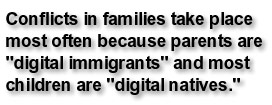
- Unlike older generations, young people are highly capable of effective multitasking, which appears to the older generation as lack of attention and lack of focus.
- Around the world there are alarming reports of Internet Addiction. For example, in Korea there have been 10 cardiopulmonary-related deaths in Internet cafés. The U.S. and the west often show similar stats, with 9% of U.S. Internet users hiding their non-essential Internet use.
- While the older generations may primarily use the Internet to gather important information and follow up on important news, younger generations use the Internet for communication, fun and gaming, to find out about each other, information-gathering, view videos, listen to music, blog, chat, share links, read news, shop, and “surf.”
- The older/parent generation, being digital immigrants, view all these online activities and multitasking as a waste of time and lack of focus. They do not understand the value of online social networking, the learning that takes place in online games, the capacity of young people to multitask, and the enormous fun, pleasure and sense of community that young people derive from these activities.
On Multitasking
Certain subjects make most parents upset, concerned and, yes, self-righteous: Parents witness their children doing homework while text messages are flying, videos are streaming, Facebook profiles are updated, Twitter is checked every couple minutes, Internet browsers are open, the loud rock music is blaring from iTunes. On top of all that, many children need to ALSO deal with nagging parents complaining about their multitasking.
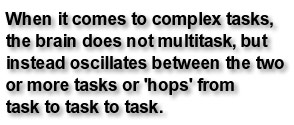 The Truth About Multitasking
The Truth About Multitasking
Most people multitask when they drive and talk on the phone or watch TV while on the treadmill at the gym. When it comes to more complex tasks, the truth is that most of the time people do not really multitask, they just think they do. The brain can’t process two high or complex levels of cognitive tasks simultaneously. When it comes to complex tasks, the brain oscillates between the two or more tasks or, one may say, the brain ‘hops’ from task to task to task. Young people’s brains seem to be able to hop better and faster between tasks than those of older people. Younger people’s reaction times are naturally faster, and this aptitude has been conditioned by the techno-culture in which they grew up. The brains of digital natives, which are known to have high levels of plasticity, have adjusted to perform seamlessly on these multitasks.
Intuitively, it seems that those who intensely multitask are not likely to comprehend, digest, and remember well the important information they read or hear while multitasking. However, research on the effects of multitasking on retention and comprehension is still in its infancy and we do not yet have conclusive results on the issue. A recent experiment in Stanford University concluded that multitaskers are not even very good in…multitasking (see a brief summary of experiment http://www.youtube.com/watch?v=2zuDXzVYZ68). Regardless, some Fortune 500 and Silicon Valley companies have instituted what they call the “Topless Meeting,” which refers to gatherings where laptops and other mobile devices, like Blackberries and iPhones, are banned in order to increase participants’ focus, attention, and productivity.
The Generational Clash Crisis
When concerned, worried, or frightened parents yell, nag, criticize, threaten or take the computer away, crisis ensues. Parents, digital immigrants, are concerned for the welfare of their children, do not understand their children’s online lives, and are frightened that the kids waste their lives with “meaningless” online activities and gaming. They are concerned that their kids will fail or drop out of school and worried that the Internet or games may ruin their children’s lives like they hear on the news.
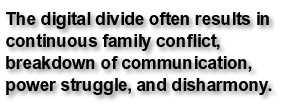 On the other hand, children, digital natives, feel misunderstood and alienated by their parents. From a child or teen’s perspective, they are simply making use of and enjoying the wide array of technological gadgets and toys available to them. Telling them not to is similar to telling a literature lover not to like books, or an avid runner to stay inside. It doesn’t make sense to them and feels like an intrusion.
On the other hand, children, digital natives, feel misunderstood and alienated by their parents. From a child or teen’s perspective, they are simply making use of and enjoying the wide array of technological gadgets and toys available to them. Telling them not to is similar to telling a literature lover not to like books, or an avid runner to stay inside. It doesn’t make sense to them and feels like an intrusion.
At times, when parents take away the computer or disconnect the Internet, some youngster has responded with violence towards the computer, themselves or even their parents. Others have fallen into depression. Most of the time, children find other ways to connect to the Web and play games. They may simply do it at a friend’s house and, in many countries, at Internet cafés.
Cycle of Parents’ Ineffective Behavior
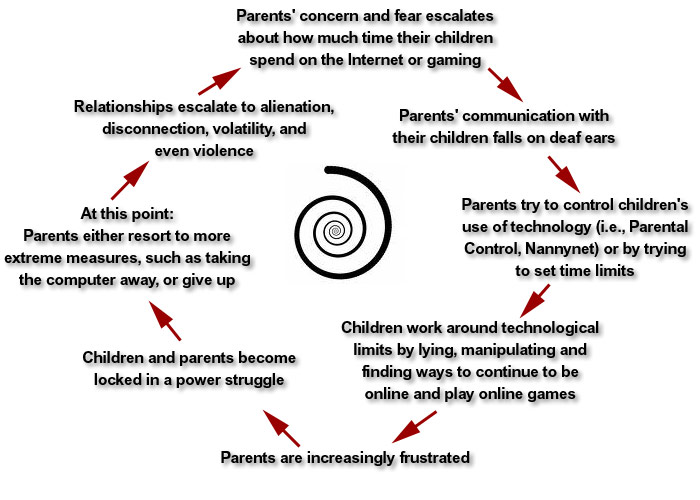
Use and Abuse of the Internet and Gaming
On Internet Addiction and Online Gaming Addiction
Experts debate whether Internet Addiction or Online Gaming Addiction can be viewed similarly to drug and alcohol addiction. Some have likened it more to a gambling addiction or shopping addiction because they do not involve actual drug addiction, development of physiological tolerance and the drug/chemical withdrawal.
The Phasic view of Internet use discusses research findings where the behavior does not escalate to a harmful place but, instead, is self-correcting. This view includes four phases:
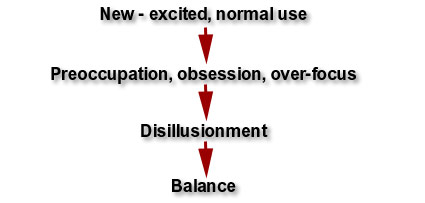
The addiction model discusses Internet use and gaming as an escalation of:
![]()
The addiction model describes these seven stages:
- Normal use
- Excessive use: School, social and work time, and resources used for gaming and web surfing. Staying up past normal bedtime
- Minimizing offline life through less time and attention to sports, reading, community, and family
- Using the Internet to fill (almost) all emotional, social, and/or sexual needs
- Out of balance, obsessed, extremely invested in online life rather than offline life
- Denial of consequences for one’s behavior
- Increased harm as a result of excessive time and energy spent online
The term addiction is used to describe a recurring compulsion by an individual to engage in some specific activity, despite “harmful or undesirable consequences.” It often includes:

- Obsession
- Compulsion
- Psychological or physical dependence
- Cannot do without
- Preoccupation
- Excessive focus, use, or behavior
- Psychological or Physical Dependency
- Craving
- Tolerance
- Withdrawal
- Interferes with “normal” life functioning
There is debate as to whether the Internet and games are addictive. This debate asks the question of whether Internet Addiction is truly a Psychiatric Disorder or a Mental Illness.
For now, American Psychiatric Association elected not to include it in upcoming (2012) Diagnostic manual, known as the DSM-5, which means that Internet Addiction or Gaming Addiction, for now, are not considered mental disorders. Even so, it is fair to say that excessive use of the Internet and gaming can be highly problematic, out of control, disruptive, and self-destructive.
Online Gaming – An Informed View
There are a growing number of researchers, gaming experts, psychologists, computer scientists, educators and sociologists who view online gaming as inherently educational and ultimately helpful in preparing players for productive engagement in our technological society. They view gaming as part of the big picture of modern technology rather than as deviant, pathological, harmful and addictive.
Researchers have identified a number of ways that the games hold the interest of and serve our children. The games:
- Are Fun!: This is why youngsters can spend so many hours playing
- Provide Challenge: Most games include some kind of challenge for the player
- Teach Mastery: Most games require increasing levels of mastery of coordination, strategy and cooperation
- Facilitate Cooperation-Communal Development: While most parents are concerned that their kids are isolated in front of the computer, in reality most games are interactional and may require high levels of collaboration, cooperation and coordination of dozens of players.
- Enhance Brain Function: Online gaming boosts memory and cognitive skills. Studies have shown that memory, puzzle, trivia and logic games can improve mental capacity in old age, effectively staving off dementia. The brain, like the body, needs exercise to stay healthy and elastic.
- Boost Self-Esteem: Each time gamers move up a level, complete a task, cooperate to defeat a common adversary, they gain a feeling of accomplishment and camaraderie.
- Provide Practice for Adult Life: Many games give children the opportunity to manage projects which require foresight, resource management and cooperation. Such games include practice at running a company or zoo, preparing a social dinner, or completing an archeological dig. Resources on Informative Websites for parents regarding different types of online games is coming up soon.
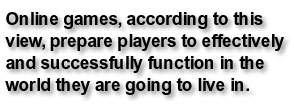 Online games, according to this view, prepare players to effectively and successfully function in the world they are going to live in. This model is quite different from most current educational institutions, which are run by digital immigrants and designed to prepare students for the old world, which will no longer exist by the time the students are adults. An ideal education meets students where they are and prepares them for the world to follow; an education that ignores the digital age, which is increasingly upon us seems to ignore a big part of reality.
Online games, according to this view, prepare players to effectively and successfully function in the world they are going to live in. This model is quite different from most current educational institutions, which are run by digital immigrants and designed to prepare students for the old world, which will no longer exist by the time the students are adults. An ideal education meets students where they are and prepares them for the world to follow; an education that ignores the digital age, which is increasingly upon us seems to ignore a big part of reality.
A Guide for Concerned Parents
Don’t
- Label your children (i.e., “You’re sick!”)
- Blame them (i.e., “You’re wasting your life!”)
- Nag
- Scold
- Prematurely threaten
- Prematurely demand that they change
- Compare them to other children
- Avoid blaming the following:
- Technology & Internet
- Game manufacturers
- Internet servers
- Friends and other children
- Friends’ parents
- School
- Genes
Do
- Observe your children with open eyes & open heart
- Be genuinely curious about what draws them to the game
- Discover:
- What do they like and enjoy about games?
- What applications & technologies are being used?
- What actual games are played?
- How are these games played?
- How much time do they spend playing?
- When do they play?
- Where do they play?
- With whom do they play?
Find the Answers to These Questions:
- How do the Internet and online games serve my child?
- Feeling of mastery, belonging, purpose, etc.
- What does s/he like about the games?
- Mastery, friendships, structure, community, challenges, competition, etc.
- What are the emotional and psychological allures of the games?
- Community, connection, excitement, etc.
- What s/he may be trying to avoid
- In the offline world (i.e., problems with school, family, friends, body image, relationships)
- In the emotional realm (i.e., depression, anxiety, low self-esteem)
- Spiritually (i.e., spiritual void)
- What are the other appeals?
Consider the Developmental Needs of Your Child:
- Developmental needs are age-sensitive
- Generally, young people explore who they are as they search for their identity
- Children’s developmental needs:
- Develop friendships – Connections
- Test limits of self, others, situations
- Challenge authority
- Safety, control, and autonomy
- Develop sexual identity
- Self-image is important – How am I being seen, perceived, liked, respected?
- At different ages, they may ask:
- Who am I?
- Who am I not?
- Who may I become?
- What are the limits?
- What is right and just?
Ways to Talk to Your Child:
- Show genuine curiosity and interest in their online lives
- Join them in their interest
- Do not demean their virtual life (it is as real to them as their ‘real’ life)
- Do not diminish the importance of the Internet & other advanced technology (this is the world they are growing up in)
- Do not ban the Internet (if at all possible)
- Propose offline activities that appeal to them in addition to (not instead of) online activities
Join Your Teen:
- Ask them to show you what they like online
- Show respect for their interest
- Request that they show you how it ‘works’
- If you are inclined, play online with your teen – Let them teach you.
Note: This may be a humbling or even shaming experience . . . but it can also be fun!Learn and Understand the Game:
- Know the game so you understand the time and inter-relationship parameters of the game
- Realize: It may take 2-3 hours to plan a raid and another 1-2 for the raid itself
- Many of the MMRPGs require planning and implementing for dozens of people for a few hours
- Don’t arbitrarily set time and day limits
- Children can plan dates and times of games in advance
- Watch or play with your children
- Do not use the game as bribery for ‘good behavior’
- Model and teach:
- Moderation
- Balance
- Correcting imbalances
- Children 12+ need to learn self-moderation so they do not ‘explode’ when they leave the house
Challenges:
- How to help parents save face while learning about the game and other technology from their children
- How to help children respectfully introduce parents to games without humiliating the parent, and without fear of retaliation
- If parents choose not to play the game or not to have the children teach them they can:
- Locate strategy guides online
- Purchase books about the game
- Watch YouTube videos on games in general, strategies, levels and types of violence, language, and sexuality
Find Out What Is Available and Propose Games:
There are thousands of educational games available on hundreds of topics.
- History, math
- Reading, writing
- Geography, biology, chemistry
- Nature, oceanography
- How to start and run a business
- How to invest money
- How to build and fix cars, bikes, motorcycles
- Mountaineering, scuba diving, surfing, skiing
- How to play soccer, basketball, hockey
- Robotic and artificial intelligence exploration
Sample list of topics and games
Find the Rating:
Online games have ratings similar to movies and television shows. The most established authority for game ratings is the Entertainment Software Rating Board, known as ESRB. Simply go to their website and key-in the names of the games your child is playing to find out the rating and if it is appropriate for your child’s age.
Assessment, Evaluation and Warning Signs of Internet Addiction
Warning Signs of Gaming Addiction
- Increased time spent in playing online
- Preoccupation that lasts beyond healthy, new excitement
- Lying or hiding gaming use from others
- Disobedience to time and other limits
- Diminished interest in offline recreational activities, such as sports, hikes, dance
- Diminished interest in essential offline self-care such as bathing, sleeping, eating. Social withdrawal from family and friends
- Withdrawal from school or work in favor of playing
- Cannot find pleasure in any activity besides online gaming
- Psychological withdrawal from the game when not playing
- Continuing to game despite its negative physical, emotional, occupational, or relational consequences
Sample of Online Assessment Tools:
- Beard and Wolf’s 2001 Criteria for Maladaptive Internet Use:
http://psychcentral.com/blog/archives/2005/08/21/beard-and-wolfs-2001-criteria-for-maladaptive-internet-use/ - HealthyPlace.com -Internet Addiction Test:
http://www.healthyplace.com/psychological-tests/internet-addiction-test/ - ReSTART Internet Addiction Recovery Program: Assessment/test available in 43 languages online at:
http://www.netaddictionrecovery.com/the-problem/signs-and-symptoms.html
When Kids Are Abusing the Web and Gaming: Intervention and Treatment Options
Parents are frequently concerned about their children’s time online. As discussed in the above, the first steps are listening to and joining your child. Refrain from nagging, yelling or threatening. If your child is not simply a member of his or her technological generation, but has a real imbalance, action may be needed. The following sections are designed to help you take action in a conscious, relevant and most of all helpful way. We know it can be difficult, and we wish you the best!

Consult with experts – one or several. Seeing a few can be useful in making an informed decision. Then, perhaps with an expert’s help, develop a well-crafted, well-informed plan of action. This may include:
- Clear limits on Internet use
- Consequences if terms of use are violated
- Meet with a counselor or psychotherapist as an individual, family or both
- Consider a structured support system, such as an online gamers support group, 12-Step or Harm Reduction interventions
- Consider residential treatment or outward bound programs (can be very expensive)
Different Approaches to Treat Internet Addiction
Parents, educators, and other concerned adults should know that there are many ways to treat Internet Addiction and Gaming Addiction. Following is more information on some of the most common options:
- Behavioral Modification. This therapy modality focuses on changing behaviors as a way to change inner state (outside → in approach). Methods include modeling, conditioning, and structured activities separate from the addiction. In the case of treating Internet and Gaming addictions, this means social and recreation activities offline.
- Cognitive Behavioral Therapy (CBT). This therapy modality focuses on changing the thought patterns that lead to certain behaviors (inside → out approach). It is founded on the belief that it is what people believe about situations they face – not the situations themselves – that determines how they feel and behave. Thus, by changing the thought patterns one can change behavior and feelings.
- Family Therapy. Often, a child or teen acting out is responding to a family system that needs attention. Especially if the user already suffers from low self-esteem, sending them to individual therapy may reinforce the notion that they are “broken.” Treating the whole family can give an important opportunity to address unhealthy dynamics that may lead to addictive behavior.
- Harm Reduction Model. Rather than demonize Internet use, gaming, or technology in general, this approach seeks to reduce the harmful effects of addiction. Harm reduction strategies meet users “where they’re at.” In a drug context, this may include clean needles. In an Internet and gaming context, this may mean going to bed at 1am instead of 4am; skipping a day of gaming and playing only six days a week; joining a sports team one season a year.
- Online Support Groups. This may seem like taking an alcoholic to a bar, but it is also an appropriate place to treat Internet and gaming addiction. Internet addicts are online anyway, and they may as well spend some time talking about addiction and treatment with others. Community is important for healing, and the opportunity to access support 24/7 can mean a lot to a user trying to cut down.
- 12-Step (AA) Model. The 12-Step program is focused on abstinence and is based on the idea that addiction is a form of treatable spiritual sickness. The model includes working on a series of steps that include humility, personal inventory, amendments, spiritual seeking, and service. Like programs for food or sex addictions, Internet, gaming, and technology 12-Step programs are based on healthy balance rather than abstinence. Most groups meet in person, with literature and outside collaboration among members for additional support. Many argue that the abstinence model is not very applicable to the Internet as the Internet is here to stay and has increasing importance in people’s lives. The 12-Step model may be more relevant to online gaming than to Internet use.
- Self Help. For those who learn well on their own, there are numerous books on Internet and gaming addiction to help a user quit addictive programs or cut down across the board. This method circumvents the possible shame of admitting to others that one has a problem and may be particularly appealing for self-starters.
- Residential Treatment Centers. Treatment centers use a variety of modalities: Group therapy, Adventure-Nature therapy, Psycho-Education, Family therapy, Individual therapy, Pharmaceutical (Medication). Users participate in a wide array of activities in a group context, which often results in higher self-esteem due to face-to-face connection and triumph or progress over addiction.
- Outward Bound. These programs are based on the idea that experiential education is paramount to learning. They often include situations with real or perceived risk, to help bring participants into the moment and physical reality. Addicts of all stripes and colors tend to be far from the present moment and their bodies; hence a treatment approach which necessitates their physical attention may be quite helpful and grounding.
In cases where therapy, 12-Step, and harm reduction are ineffective, a traditional treatment center or Outward Bound program may be appropriate. These centers take the user out of their familiar surroundings, in most cases away from access to technology. Residential treatment can be quite expensive and is generally used as a last resort for extreme cases. For instance, if your child has stopped going to school or work, refuses to eat, shower or leave their room, measures like this may be worth considering.
Parents are advised to do research on prospective treatment centers by interviewing staff, program graduates, and reading online reviews whenever possible. Putting one’s child in the care of a facility for addiction treatment should not be done lightly. A worst-case scenario is that the child becomes more damaged in treatment. So, do your research.
When performed skillfully and with care, residential treatment and Outward Bound centers can facilitate growth and build self esteem. They teach skills often lacking in gamers and Internet addicts, such as face-to-face cooperation and camaraderie, physical stamina and activity, and a connection to nature.
Remember: The Internet is here to stay. The best outcome for those who overuse, abuse or are addicted to the Internet or to gaming is to find balance between online and offline life. There is a spectrum of healthy use, and some may use the Internet only for necessities, while other healthy users are online for hours a day. The goal is not to avoid the Internet altogether – this is unrealistic and unhelpful. Balanced use or harm control are the best and most promising outcomes. In this regard, Internet Addiction is likely to be treated as food addiction rather than drug addiction.
On Balance
 We can find ways to enjoy the Internet and online gaming. Use them well, cope/deal with their dark sides, stop demonizing them, and most importantly, live with balance.
We can find ways to enjoy the Internet and online gaming. Use them well, cope/deal with their dark sides, stop demonizing them, and most importantly, live with balance.
- High speed and low speed
- Acceleration and stillness
- Watching online trading and watching sunsets
- Reading blogs and emails and reading hardcover books, poetry, or sacred texts
- Engaging in virtual and face-to-face communication
- Surfing the Internet and surfing the Inner-net
Cyber-Wellness is a practical approach to people’s relationship with technology that emphasizes safety, awareness and respect in matters pertaining to the Internet. It addresses needs for physical, psychological, communal, emotional, spiritual, and vocational/occupational well-being and the importance of a balanced life while using Internet technologies. Cyber-Wellness philosophies and practices are best implemented with sensitivity and respect to generational, cultural and individual differences in background, attitudes, outlook and relationship to technology.
Summary
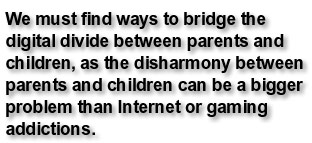 The Internet and online gaming are a part of the world we live in and that our children grow up in. Like a hammer, it can be used for help or for harm. We must find ways to bridge the digital divide between parents and children, as the disharmony between parents and children can be a bigger problem than Internet or gaming addictions. In this increasingly technological culture, children need our guidance, not our resistance, in navigating the world they inherit. Rather than demonize the digital age, we can show them the beauty of the natural world and help them use technology as the helpful tool that it can be. Of course, to teach something, one must be willing to learn about it. When children see their parents showing interest in their world, they will be more willing to hear input about it.
The Internet and online gaming are a part of the world we live in and that our children grow up in. Like a hammer, it can be used for help or for harm. We must find ways to bridge the digital divide between parents and children, as the disharmony between parents and children can be a bigger problem than Internet or gaming addictions. In this increasingly technological culture, children need our guidance, not our resistance, in navigating the world they inherit. Rather than demonize the digital age, we can show them the beauty of the natural world and help them use technology as the helpful tool that it can be. Of course, to teach something, one must be willing to learn about it. When children see their parents showing interest in their world, they will be more willing to hear input about it.
At the end of the day, our children will make their own choices about whether and how they use the Internet and gaming. The best we can do is set a good example, clear boundaries, and impress upon them values of balance between online and offline life. With help, we can make a cultural shift to help new generations view and use the Internet and gaming as tools for healthy and sustainable use.
Zur Institute’s Resources
- Online Certificate on Psychology of the Web: Zur Institute offers a 15 hour certificate program on Psychology of the Web.
- Educational Games
- Technology & Gaming Podcast (Transcript)
- Invite Dr. Zur to present to your school, institution, or organization. Dr. Zur has been presenting for the public and for professional audiences all over the world for over 30 years.
- Dr. Zur’s CV
- Contact Dr. Zur: info@zurinstitute.com
- The Zur Institute offers over 125 online Courses on multiple topics and is widely accredited to provide continuing education for Psychologists, Marriage and Family Therapists, Social Workers, Counselors, Addiction Counselors, Professional Counselors, and Nurses.
Online Resources and References
- Entertainment Software Rating Board: Rating of Games
http://www.esrb.org/ratings/ratings_guide.jsp - PBS Documentary on “Digital Nation” and other resources technology, Web and online gaming:
http://www.pbs.org/wgbh/pages/frontline/digitalnation/?utm_ campaign=DigitalNation&utm_medium=Search&utm_source=DigitalNationBrand - Larry Rosen, Ph.D. on Psychology of the Technology. Excellent free resources and books:
http://drlarryrosen.com/ - John M. Grohol, Psy.D. offers a critical look at the idea of Internet Addiction
http://psychcentral.com/netaddiction - Dr. John Suler, Ph.D.: The Psychology of Cyberspace:
http://www-usr.rider.edu/~suler/psycyber/psycyber.html - Dr. Atiqul Haq Muzumder provides an informative PowerPoint presentation at
http://www.slideshare.net/atiq10/internet-addiction-1645782 - New York Times article: “Texting, Surfing, Studying?” October 2009.
http://www.nytimes.com/2009/10/13/health/13klas.html?_r=2&em - Informative websites for parents regarding different types of online games
- Ezine Articles: Online Games – Types Of Popular Games
http://ezinearticles.com/?Online-Games—Types-of-Popular-Games&id=6582905 - James Paul Gee, Ph.D.: Many aspects and types of online games
http://www.jamespaulgee.com - More For Kids.Com: The Benefits of Online Gaming
http://www.more4kids.info/673/online-games-for-kids/ - Science News for Kids: What Video Games Can Teach Us
http://www.sciencenewsforkids.org/2004/01/what-video-games-can-teach-us-2/
- Ezine Articles: Online Games – Types Of Popular Games
- Books and Videos
- David Williamson Shaffer: How Computer Games Help Children Learn
http://www.amazon.com/Computer-Games-Help-Children-Learn/dp/0230602525/ref=pd_sim_b_1 - Mark Prensky: Don’t Bother Me Mom–I’m Learning!
http://www.amazon.com/Dont-Bother-Me-Mom-Im-Learning/dp/1557788588/ref=pd_sim_b_5 - James Paul Gee: What Video Games Have to Teach Us About Learning and Literacy.
http://www.amazon.com/Video-Games-Learning-Literacy-Second/dp/1403984530 - Russel DeMaria: Reset: Changing the Way We Look at Video Games
http://www.amazon.com/Reset-Changing-Video-Currents-Hardcover/dp/1576754332/ref=pd_sim_b_5
- David Williamson Shaffer: How Computer Games Help Children Learn
* The terms “Digital natives” and “Digital immigrant”, by some accounts, seem to have been initiated by Dr. Christakis.


